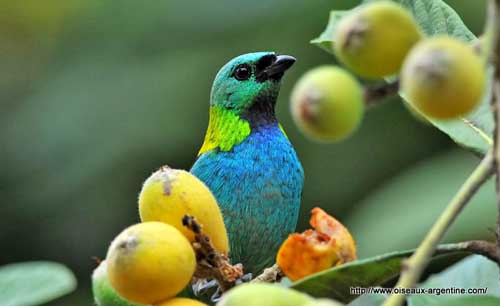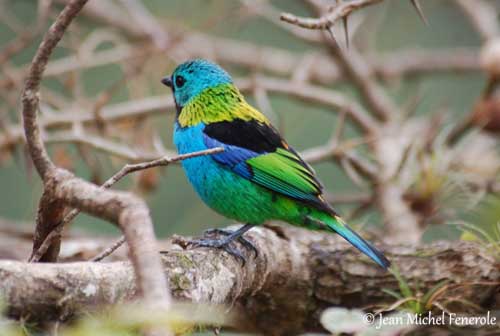
Fr: Calliste à tête verte
All: Dreifarbentangare
Esp: Tángara Regia
Ital: Tangara testaverde
Nd: Prachttangare
Sd: Grönhuvad tangara
Port: Saíra-sete-cores
Esp (Argentine): Saíra arcoiris, Tangará aroiris
Photographers:
Jean Michel Fenerole
Photos d’Oiseaux du monde
Philippe and Aline Wolfer
OISEAUX D'ARGENTINE
Text by Nicole Bouglouan
Sources:
HANDBOOK OF THE BIRDS OF THE WORLD Vol 16 by Josep del Hoyo- Andrew Elliot-David Christie – Lynx Edicions – ISBN: 9788496553781
BirdLife International (BirdLife International)
Green-heared Tanager
Tangara seledon
Passeriforme Order – Thraupidae Family
BIOMETRICS:
Length: 13 cm
Weight: 16-20 g
DESCRIPTION:
The Green-headed Tanager is a small colourful bird which frequents mainly the humid Atlantic forest. And contrary to we could think, its flashy plumage is a good camouflage among the vegetation.
The adult male shows bright complex plumage. Head, nape and chin are bright aquamarine-green. A pale yellow-green broad band crosses the nape and the upper mantle, and extends around on the neck sides to the throat. Back and scapulars are black. The rump is orange-yellow whereas the uppertail-coverts are bright apple-green.
The tail is black with pale green edges at base, turning turquoise-blue distally. The upperwing-coverts are dark violet-blue. The alula and the primary-coverts are black with violet-blue edges on the outer webs. The flight feathers are black with broad pale green edges.

On the underparts, the lower throat and the upper breast are black. Breast and central belly are bright turquoise-blue, whereas sides of belly, flanks and undertail-coverts are bright apple-green.
The bill is black with black base. The eyes are dark brown with black eyering. Legs and feet are blackish-grey.
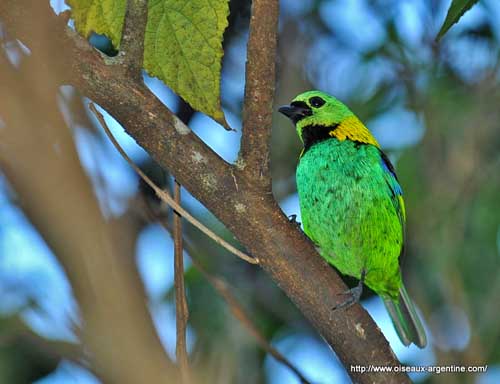
The female has almost similar plumage but she is slightly duller overall.
The immature is much duller than adults.
VOICE: SOUNDS BY XENO-CANTO
The Green-headed Tanager utters high-pitched calls, some ascending buzzy ‘zweet” sometimes followed by other rapid twittering notes “zwee-dit-see” or “zwee-di-di-di-di”.
The sing is given at dawn from high perch, often the crown of a tree. This is a high-pitched, trisyllabic phrase, steadily repeated up to 90 times per minute “sir sir sweet”.
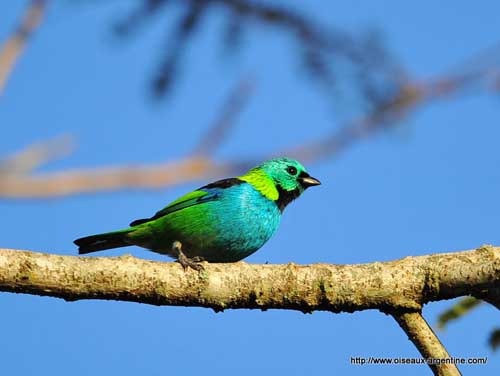
HABITAT:
The Green-headed Tanager is usually found in humid Atlantic forest, and can be common in orchards, parks and gardens, even near human settlements. It also frequents the forest borders and the clearings where it finds some trees and shrubs, and also the second growths.
This species is visible from lowlands to 900 metres, but they are more often seen at lower elevation.
RANGE:
The Green-headed Tanager is found in SE Brazil and adjacent parts of SE Paraguay, and NE Argentina.
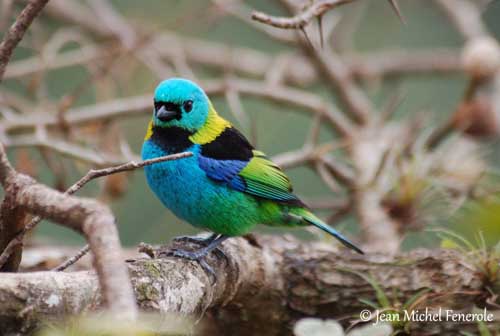
BEHAVIOUR:
As numerous Thraupidae species, The Green-headed Tanager feeds on fruits and arthropods. The fruits include a wide variety of cultivated and wild fruits, and berries from Bromeliads.
This species can be seen in pairs or in small groups, sometimes up to 20 birds. They may join mixed-species flocks for foraging.
They usually search for food from middle-height to canopy, between 9 and 25 metres above the forest floor. It may forage along the borders of the forest and also in disturbed areas.
This small bird is very active when foraging, performing some acrobatic movements while hopping along branches, gleaning from leaf surface and bark, and from vegetation. It also inspects the sides of the bare branches by leaning down several times. It is able to manipulate the fruits with the bill, in order to remove the seeds and to reach the pulp.

The Green-headed Tanager is monogamous. In the genus Tangara, the breeding pair is accompanied by helpers, probably young from the previous broods. But a single adult pair is involved in nest-building, egg-laying and incubation.
Courtship feeding by male to female is sometimes reported. It may feed the female away from the nest, or occasionally at nest. The female may also feed the male sometimes.
The Green-headed Tanager is resident in its range. Some seasonal movements are observed between the forest and semi-open habitats.
FLIGHT:
The Green-headed Tanager is a good flier and performs fast flight within its territory.
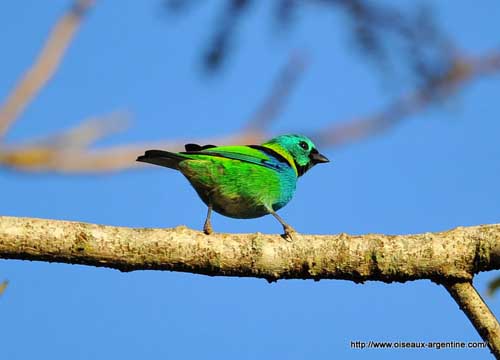
REPRODUCTION:
The breeding season occurs between November and February in Brazil, in November and December in Paraguay, and in November in NE Argentina.
The nest is a compact cup built by both adults with grass and leaves, and lined with soft materials. This nest is usually hidden in the vegetation, in foliage of tree or scrub, or in plants along trunks and branches.
The female lays 2-3 pale eggs, pinkish-white with brown and grey markings. The incubation lasts 13-14 days by female. The young fledge about 14-18 days after hatching. They still depend on parents for food for several weeks after fledging.
A second brood is often attempted. The young from previous broods may accompany the adults for several months during the first year.
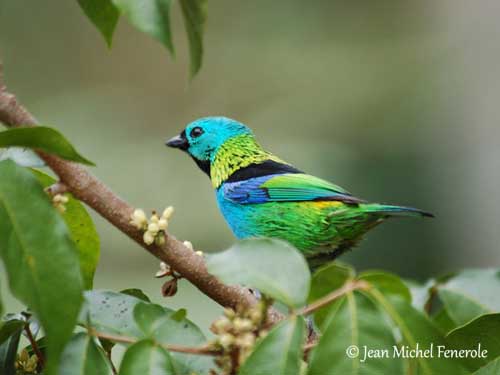
DIET:
The Green-headed Tanager feeds primarily on fruits, both cultivated and wild, such as oranges, papayas and bananas, and wild fruits such as figs from Ficus, and others from Hamelia and Urtica. It also takes berries from Bromeliads, seeds and insects.
PROTECTION / THREATS / STATUS:
The Green-headed Tanager is uncommon to fairly common locally. This species has disappeared from large recently deforested areas, and it is also absent from remnant woodlands in SE Brazil. This suggests that their distribution is today highly fragmented. The populations are often confined to protected areas.
However, this species is not currently threatened.
